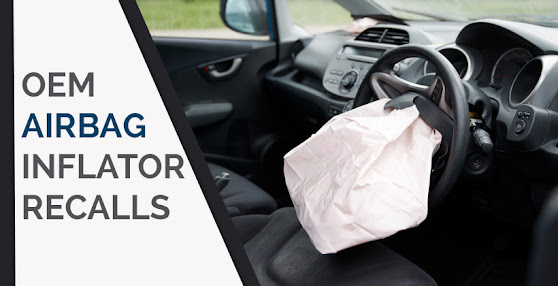Update on OEM Airbag Inflator Recalls
Original OEM Airbag Inflators Recall
The original Takata airbag recall, which began in 2014, is the largest automotive recall in history. 67 million front (driver or passenger) airbags in the United States (and over 100 million worldwide) were involved. These airbags have been implicated in 28 deaths worldwide (19 in the US) and more than 400 injuries.
Under certain circumstances, the inflators (which contain a metal cartridge loaded with propellant wafers) can explode and (rarely) send deadly metal fragments flying into the vehicle’s interior. Airbags that contain ammonium-nitrate-based propellant without a chemical drying agent are at risk. It is believed that high temperatures, high humidity, and age of the airbag are contributing factors to the malfunction. Thus far, 50 million Takata airbag inflators have been repaired or otherwise accounted for by the NHTSA.
Current News - OEM Airbage Inflator Recall Updated
On September 20, 2021, the National Highway Traffic Safety Administration (NHTSA) announced a new investigation into another 30 million potentially affected vehicles built by more than 20 car manufacturers between 2001 and 2019, among them Honda, Ford, Toyota, General Motors, Nissan, Subaru, Tesla, Ferrari, Mazda, Daimler, BMW, Chrysler, Porsche, Jaguar, Land Rover, and others. The investigation covers vehicles outside the existing recall that has already affected 67 million vehicles. The airbags in question were fitted as original equipment and as part of prior airbag recall efforts. No present safety risk has been identified, and the driving public doesn’t need to take any action.
However, the NHTSA believes further study is needed to determine the potential future risk of non-recalled desiccated inflators. These inflators contain a desiccant, or drying agent, which is supposed to prevent moisture from degrading the device. If the desiccant eventually becomes saturated and can no longer absorb water, it can begin to degrade, and hence the airbag may act unexpectedly if triggered and deployed. It is possible that the same explosive shrapnel problem that plagued the original airbag inflators could affect these desiccated inflators as well.
Putting The Danger In Perspective
More than 400 injuries and 19 fatalities have been linked to the Takata airbags in the U.S. In some cases, the incident was horrific, with metal shrapnel penetrating the driver’s neck and face. As awful as they are, such incidents are very rare. In June 2015, Takata stated that it was aware of 88 airbag ruptures in total: 67 on the driver’s side and 21 on the passenger’s side out of what it calculated was just over 1.2 million airbags. Airbags are a critical safety device in modern vehicles, and the Department of Transportation estimates that between 1987 and 2015, frontal airbags have saved 50,457 lives.
According to the information given by Takata and acting under a special campaign by NHTSA, the involved automakers are responding to the safety risk by recalling all vehicles that have these specific airbags.
File For Compensation
Takata victims who are considering seeking recourse through the Takata Airbag Tort Compensation Trust Fund (TATCTF), the Individual Restitution Fund (IRF), and the Participating Original Equipment Manufacturer (P-OEM) Honda North America, Inc., Channeling Agreement Fund (P-OEM Fund) had until April 11, 2021, to file a Notice of Claim and Claim Form for accidents that occurred more than 3 years ago, i.e., on or before April 11, 2018. Anyone injured by the defective Takata airbag after April 11, 2018, has 3 years from the date of their accident to file notice. Failure to file a Claim Form or Notice of Claim by the deadline means the victim’s claim will be barred forever.
CWE's Role In Airbag Disposal
In 2019, CWE stepped in to support the industry and help address the public safety issue. Recalled airbags with ammonium nitrate as the propellant was sent to our hazardous waste permitted facility (our facility was 1 out of 3 facilities that are RCRA-permitted to accept these devices).
Our airbag destruction process results in the re-use or recycling of nearly 100% of the residuals produced. The ammonium nitrate is safely extracted and sold to the fertilizer industry. The metal is sold to the steel mills for use in the appliance, auto parts, and other devices. The cardboard shipping containers in which the airbags arrive are recycled as well.
To read more about CWE’s airbag inflator initiative, see this press release.




Comments
Post a Comment